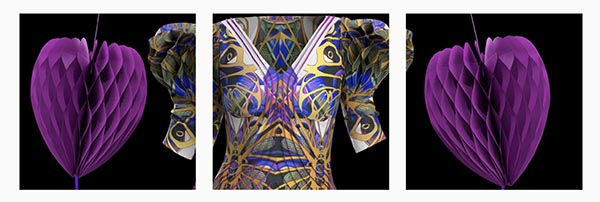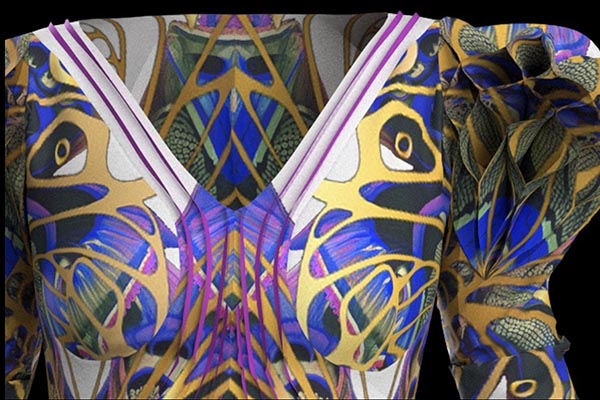
(Image Credit: Estelle Pearce)
Meet the super talented Leeds Arts University MA Digital Fashion graduate Estelle Pearce, who was selected to showcase her work at Digital Fashion Week New York and London Fashion Week.
Estelle is a “phygital” (physical plus digital) designer and creative pattern cutter with more than 15 years’ experience in the fashion industry, working in couture, high-end, and high street markets. She uses digital environments to push her creativity and explore sustainable solutions.
We interviewed Estelle to find out more about her work and how she utilizes technology to explore her creativity.
Debbie McKeegan: When and why did you decide to follow a creative career?
Estelle Pearce: Working in the fashion industry doesn’t always allow for the creative freedom envisaged when setting out as a designer and pattern cutter, and for many years I felt there was something missing. The pandemic proved to be my saving grace; my curiosity and discovery of digital fashion allowed me to indulge my creativity, freeing me to experiment, explore, have fun, and ultimately create without the worry of waste. I feel very lucky to be doing what I’m doing. When I look back at my journey to now, I feel my experiences were setting me up to be in this position.
DM: Can you tell us about your career journey so far?
EP: Leaving school with only GCSEs, I worked for many years as a technician and assessor for a local pharmacy; and as much as I loved it, I knew it wasn’t forever. Seeking ways to indulge my creativity, I enrolled in sewing and pattern-making courses and soon realized my passion, leading me to enroll on an Art Foundation Degree and then onto a BA(Hons) Fashion Design Degree where I had the opportunity to work for couture label Boudicca and exhibit at Graduate Fashion Week. After graduating, I worked for a manufacturing company, designing women’s- and childrens-wear for high street brands. Realizing a need to up-skill, I later undertook a Postgraduate in Creative Pattern Cutting and started a new position that allowed me to be in control of the design and patterns for a luxury nightwear collection.
The pandemic was pivotal in my career, as I began to research sustainability and issues that were affecting the fashion industry. I soon discovered the world of technology and was hooked, which led me to complete a Master’s degree in Digital Fashion; and I’ve since been working as a freelance designer and associate lecturer.
DM: Tell us about your love of tech and how you discovered 3D simulation and the NFT environment?
EP: As I mentioned earlier, I began to sit up and listen to what was being discussed about digital fashion during online seminars and summits focused on sustainability. Once I started to use the technologies within my own practice, I soon became hooked and wanted to learn everything, quickly understanding the possibilities I could explore. I haven’t been quick to jump into the NFT market, which stems from my need to include utility to the assets, but I was fascinated by how quickly the market grew—although it does seem to have taken a backward move, it will be interesting to see how it progresses. Using 3D simulation within my practice has enabled me to become more than a fashion designer, and I now see myself as a visual creative.
DM: How do you use digital environments to push your creativity and explore sustainable solutions?
EP: Building digital creation into your workflow alone can be a sustainable solution in its ability to reduce sampling waste and its efficiency in accurately communicating with an audience or others in the supply chain. Once assets are digitized, further opportunities can be accessed that have the potential to alter how we engage with fashion. Part of my research was focused on brands that are using digital technologies along with sustainable practices to offer goods that are made on demand. To me, this is a true way of combining the two elements towards sustainable solutions.
Within my practice, I have further explored incorporating other technologies like laser cutting, 3D printing, and coding, created augmented reality try-on, and more recently created a wearable for Ready Player Me.
DM: Creating “digital twins” requires great skill and technical pattern knowledge. What does that involve?
EP: Understanding pattern, garment, and material construction are of great benefit when creating digital twins. And when it comes to creating digitally, you have to be aware that the standard construction of a garment may not be what is right in the digital world, and this also needs to be assessed in order to achieve the best visual outcomes.
Early in the start of my 3D learning, I created digital twins of my post-graduate pieces in order to test pattern-cutting and draping within CLO3D, while better understanding how to create the required materials. I found this a challenge at times, especially when creating intricate details and exact patterns, but it was a great experiment, and I was pleased with the finished garments. What I found more exciting was the ability to quickly visualize multiple iterations.
DM: How do you see the future of fashion—will we have a hybrid industry?
EP: I have witnessed changes taking place in the fashion industry from the increase of microfactories with digital printing facilities, to on-demand fashion, brands moving into digital environments, incorporation of technologies within items, and items that are fully or partly 3D-printed. I feel the changes are already starting to take place and the fashion industry is having to quickly move with the times in order to remain relevant.
DM: Is the metaverse a viable option for sustainable fashion?
EP: The metaverse offers us an alternative way to consumer fashion to express individuality where anything is possible. During my Masters, I centered my thinking around “Design with the Omniverse in mind,” considering that the metaverse offers new approaches while also stopping to consider what could be possible in the physical world. Having a strategy that enables both to be considered can certainly help towards creating a more sustainable world.
DM: How does technology need to evolve to deliver and meet designer’s and consumer’s expectations?
EP: We assume that everyone is tech-savvy or has access to digital technologies; but unfortunately, this isn’t always the case. Accessibility and education are key to increasing consumer and designer expectations. Personally, the tools I use improve with each update, which makes my workflow more satisfying and less stressful. It has taken much commitment and ongoing learning to get to the level I am at now, and I can certainly appreciate the struggle of initial onboarding digital technologies to established teams.
DM: Finally, in your digital journey you have overcome many challenges. What lessons did you learn?
EP: I wouldn’t like to count the number of hours that I sat feeling frustrated by a particular project, challenge, or deadline, when nothing seemed to be working the way I wanted; YouTube was my best friend. But strangely, some of the best discoveries happened when I least expected them; and I’d often stumble on new ways of working or experimenting with functions I’d not tried before.
DM: What advice would you give to an emerging designer just setting out?
EP: There are many free online resources that can help improve your skills as a digital designer. If you’re new to digital fashion, try a free trial of CLO3D or Marvellous Designer and start on their beginner’s guide on YouTube.
For the more digitally advanced, consider including other free software like Daz3D and Blender to further enhance your creativity and offer.
To gain some exposure, enter competitions or events like Digital Fashion Week New York and London—attend events, talk in person or online, be open to collaborations, try alternative ways of working, and remain curious.

(Image/Video Credit: Estelle Pearce)










Discussion
Join the discussion Sign In or Become a Member, doing so is simple and free